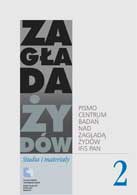Jan Grabowski see in PDF University of Ottawa
University of Ottawa
Response to the Review
by Tomasz Domański Entitled Correcting the Picture? Reflections on the Sources Used in "Night Without an End. Fate of Jews in Selected Counties of Occupied Poland"”
(Polish-Jewish Studies, Institute of National Remembrance [Warsaw, 2019])
Night Without an End Fate of Jews in Selected Counties of Occupied Poland is a two-volume study devoted to the fate of the Jews across nine counties in occupied-Poland, the result of many years of research conducted by a team of scholars. The individual studies address, for instance, the fate of Jews, the German policy of terror, Polish society’s actions and reactions, and the attitudes of the underground organizations to the Holocaust, which took place in plain sight. Our book has garnered great interest among readers. and has also become a starting point for numerous discussions and an object of, mostly positive, reviews. The Polish state in the form of the Institute of National Remembrance (Instytut Pamięci Narodowej, IPN) has recently joined the discussion by publishing several reviews written by the institute’s employees. The longest of such reviews, and the only one I will refer to, is that penned by Dr. Tomasz Domański, an employee of the Kielce branch of the IPN. He published a lengthy review, exceeding seventy pages, devoted to our book, which I co-edited and co-authored. Domański’s report is predominantly a testament to his courage, for although he is not particularly distinguished in research on Holocaust history, he eagerly renders harsh judgments against scholars who have devoted many years to this subject.
Importantly, this review repeatedly refers to unpublished manuscripts authored by other IPN employees. For example, Domański refers to a manuscript by Tomasz Roguski (an employee of the Warsaw branch of the IPN) devoted to Węgrów county, the manuscripts written by Katarzyna Pawlak-Weiss (the deputy director of the Wrocław IPN branch) and Krzysztof Kupeć (also from the Wrocław branch) about Złoczów county, the manuscript written by Dawid Golik (from the Cracow branch) about Nowy Targ county, and finally, the manuscript by Sebastian Piątkowski (a Radom branch employee) about Łuków county. Consequently, this review is not so much a scholarly report than it is the product of the collective effort of clerks, delegated by their superiors to perform this special task. Despite its intention, this review does not constitute an intellectual polemic; it is, rather, an attempt to damage the reputation of independent scholars.
Of the many sources Domański refers to include works by a Mark Paul. As a matter of fact, said Mark Paul does not exist; a fact known to every scholar who is familiar with Holocaust historiography. Mark Paul is the pseudonym of an author (or authors) of lengthy online documents laden with anti-Semitic clichés and stereotypes which have been available online for years. Unfortunately, Domański evidently does not realize that referring to anti-Semitic documents in a scholarly review of a work devoted to Holocaust history does not portray him, nor the institution which he works for, in a positive light.
But let us get to the point. Domański’s report consists of two parts: general criticisms and detailed criticisms. I will first address the former, which pertains to the entire book including the introduction (written by Professor Barbara Engelking and myself). Afterwards, I will move on to some of this IPN employee’s more detailed critiques of my chapter.
Firstly, Domański criticizes the fact that some of our studies address German consolidated counties (Kreishauptmannschaften), while others concern pre-war Polish counties. I do not understand the basis of this accusation, as such processes of selection are clearly explained in the introduction as well as in each study. More importantly, Domański’s criticisms are simply groundless to every historian who has even cursory knowledge of the methodology of microhistory; the methodology of conducting microhistorical research on the territory of a smaller pre-war Polish county is exactly the same as that used in the case of the slightly larger consolidated counties. This is discussed in detail in our book. The administrative units vary in size, yet this does not change the method, the source basis, nor the conclusions. Domański erroneously presents this as a great methodological shortcoming of our book.
Secondly, Domański frequently criticizes us for our failure to use certain archives, such as the Ossoliński National Institute. This accusation is doubly ungrounded. For one, not all searches succeed. Despite spending many hours in an archive, a scholar may fail to locate any sources which should be taken into consideration or which would in any way alter our understanding of the subject matter in question. In a normal scholarly review a critical scholar attempts to indicate which sources were omitted (usually providing their titles and file numbers), and demonstrate how their inclusion could have impacted the publication. In Domański’s review, however, one finds nothing of the sort.
The author of this IPN report criticizes us for presenting Polish-Jewish relations of the late 1930s in dark colors. In reference to my chapter, Domański writes: “If the author had presented a broader background of the mutual relations during the interwar period in the context of the economic life he would have had no basis for ending this thread with the following outright absurd sentence: ‘The outbreak of war found the Jewish community in full retreat and the violence against the Jews, so visible during the late 1930s, was to increase dramatically with the arrival of the Germans’” (Domański, 8). What makes Domański regard this statement as absurd? Even a cursory glance at the pre-war Polish police reports, county governors’ reports, and also the despairing descriptions of the Jewish communities’ situation which were streaming into YIVO in the late 1930s provide irrefutable evidence for its truthfulness. Domański seems to further insinuate that I distorted the truth: “Who caused the escalation of the violence against Jews? Could it be that contrary to facts the author is persistently trying to inscribe the Holocaust, conducted by the Germans during World War II on the occupied Polish territory, in the picture of the disputes between the two communities which lived in the free country before 1939?” (9). I simply stated that at the outbreak of war, the Jewish community was significantly weakened economically and that Polish-Jewish relations had deteriorated. Such an opinion is neither new nor is it particularly groundbreaking. This example is illustrative of the persistent lack of depth in Domański’s argumentation. Quite amazingly, in his attempt to discredit my evaluation of the economic situation of Węgrów’s Jewish population, Domański makes reference to a work devoted to Kielce!
Another reservation voiced by the reviewer concerns our discussion of the role of Poles in the administration of occupied Poland: “In the context of the most basic elements of the description of the occupation a historian should be shocked by the term ‘Polish-German administration’ which appears in the introduction next to the ‘German administration’ (Engelking, vol. 1, 9). This apparent triviality illustrates the categories in which the authors of the introduction (that is, at least 2 of all the authors of this publication) think. They do not explain what they mean by that term, nor do they seem to notice that using it is — euphemistically speaking — a factual mistake” (Domański, 9). In this passage, Domański formulates a new construct from which an accusation emerges: “What Polish state one can one speak of besides the German state in the context of the occupation administration under the Third Reich? Did the authors conclude that the Polish state functioned in some overt form under that administration?” (9). This passage reveals another of the author’s manipulations; he accuses us of suggesting that a ‘layer’ of the Polish state existed under the German occupation. Of course, we do nothing of the sort. Let me quote the fragment of the introduction from which Domański draws this most serious accusation. Here is the incriminating passage: “Our studies of the counties are based on documents from Polish, Israeli, American, German, Ukrainian, Belarussian, and Russian archives. We considered documents produced by the Polish Underground State, Polish authorities in exile, Jewish social self-help organizations, German-Polish and German administration, the gendarmerie and blue police, the underground and the collaborationist reptile press, etc.” (Engelking, Grabowski, vol. 1, 19). I wish to emphasize that this is the only place where the expression ‘Polish-German administration’ appears in either of the two reviewed volumes, and it evidently pertains exclusively to the primary source methodology. As a matter of fact, some offices in the General Government produced the vast majority of their correspondence in Polish and were staffed almost exclusively with Poles. To Domański, however, this argument seems invalid. It takes much ill will to draw such broad conclusions regarding the existence of the ‘Polish state’ under the occupation from the quoted passage!
Let us assume for a moment that Domański’s review is a scholarly one through which the author wishes to engage in a dialogue with the reviewed work, and discuss the subject of Poles’ agency under the occupation. Domański’s opinion - which reflects the official narrative of the IPN - is that from the beginning of the occupation, any Polish control of the official, state realm was completely eliminated. Faithfully repeating the position of the institute which employs him, the reviewer suggests that with the collapse of Polish statehood Poles ceased to have any influence on the administration - from then on the situation was entirely in German hands. ‘What went wrong had nothing to do with us,’ the author seems to say. The historical reality, however, was far more complex. The system of German occupation attempted to engage and coopt local forces as much as possible, both when that served the occupier’s interests or was of no particular importance. This is known to historians from all countries of formerly occupied Europe. Let us take the example of the wartime Polish judiciary. During the war, a network of municipal, regional, and appellate courts remained intact, through which Polish judges passed tens of thousands of verdicts in both criminal and civil cases. Polish prosecutors accused, and Polish defense lawyers defended, all in accordance with pre-war Polish law. Polish courts also ruled on ‘Jewish’ cases, and those judicial decisions were not unimportant to Polish Jews. This entire system functioned with minimal German involvement - and I do know something of this topic, having devoted years of work to the subject. Let us now take a look at the administration on the level of cities and towns, and also lower, that is, on the rural level. On this level the Germans also relied upon Poles, and gave them some freedom within which to act. The same phenomenon took place in Ukraine, in the occupied territories of the USSR, in the Balkans, not to mention the occupied countries of Western Europe. To learn about the German methods of administrating the occupied territories it is sufficient to read the works by Max Bergholz, Omer Bartov, Christopher R. Browning, Evgeny Finkel, Tal Bruttmann, Laurent Joly, Martin Dean, or the results of the recent research conducted by Grzegorz Rossoliński-Liebe.
In terms of the agency of Poles and their participation in the administration of occupied Poland on the level of counties and villages (which is precisely our research area), the matter is clear. No historian familiar with the local government’s jurisdiction can doubt the autonomy of the rural Polish government’s actions with regard to the ‘Jewish’ issue. Here, choice was possible, despite the severe punishments threatened by the occupier - in the same way that functionaries of that administration decided whether to partake in the implementation of the occupier’s orders concerning security, fighting the underground, or the war economy. As evidence, all authors of the studies included in the two volumes of Night Without an End, including myself, provide hundreds of examples and propose individual interpretations of that phenomenon.
Another objection, which is discussed at length, concerns our evaluation of the role of the blue police – which Domański regards as erroneous. He writes: “One can have an impression that the authors intentionally do not comment even once on the German provenance of that formation. Though they seemingly use mostly its German-given name (Polnische Polizei — Polish Police), the formation is in fact referred to predominantly as the ‘Polish police’ — without capitalization or inverted commas, and without revealing its true character to the reader, which, in the linguistic layer, further strengthens the impression that that it was of a Polish and not German character. The authors present it as if it had truly been an element of the Polish state’s operation beside the German administration” (10). However, Domański makes no reference to research that could disprove our findings about the complicity of this formation in the extermination of Polish Jews. On hundreds of pages we present, as much as it is possible, the great extent of the Polish Police’s own initiative in that very regard. We give dozens of examples that illustrate how Polish policemen (overwhelmingly pre-war functionaries of the State Police) robbed and murdered Jews under German supervision. Using equally as many examples, we prove that the blue police had a great deal of autonomy precisely in regards to the ‘Jewish question.’ This is well-documented in our study, and easily identified while reading. Polish policemen not only participated in starving the ghettos and robbing the Jews, but also in virtually all liquidation campaigns in the General Government. Furthermore, after the liquidations were complete, blue policemen were one of the most ‘effective’ murderers who hunted down the Jews hiding on the ‘Aryan’ side. These individuals have the “death of hundreds of thousands of Polish Jews” on their conscience, as Emanuel Ringelblum wrote. Once again, it must be emphasized that in our studies we provide plenty of examples of Polish policemen murdering Jews of their own volition, without the Germans’ participation or knowledge. However, Domański’s stance on the matter in question is in perfect accord with the official narrative of the IPN - his employer.
The reviewer directs similar biased accusations at our presentation of the Voluntary Fire Brigades’ participation in the liquidation of Jewish communities. Domański writes: “The reader will not learn from either the introduction or the main text that by virtue of General Government Governor-General Hans Frank’s 22 April 1941 ordinance, same as other types of fire brigades, the Voluntary Fire Brigades were militarized within the framework of the services subordinate to the Reich as a ‘German technical unit of police auxiliary service’. […] Thus the Voluntary Fire Brigades remained voluntary only in their name” (16). One must be truly unwilling to understand the logic of VFB’s participation in the liquidation campaigns to make do with such an objection. The firemen exhibited a high degree of initiative, as illustrated by the extremely detailed description of the Aktion in Węgrów (Engelking, Grabowski, vol. 1, 424–454): They often joined in the liquidations even without a clear German order. One Polish woman testified after the war that: “on Jatkowa Street in Węgrów I saw fire brigade commander Wincenty Ajchel order a search for Jews, and Wacław Ajchel, son of Franciszek, along with other firemen, five in total, escorted two Jewish sisters from a hideout, one of them with a child in her arms. Those Jewish women were daughters of a butcher from Węgrów, by the name of Kuper” (452). The underground periodicals published by the Home Army (Armia Krajowa, AK) and the testimonies of the sparse Jewish survivors, both quoted in our study, emphasize the firefighters’ voluntary, independent, and murderous participation. Equally numerous are the testimonies and accounts given by Polish witnesses, for example: “According to Węgrów mayor Władysław Okulus, who is very well-informed, the Węgrów firefighters joined in the liquidation campaign first thing in the morning, and of their own free will” (445). Significantly, the participation of the Polish firefighters became even more important when German presence was lower in a given area. As I discussed, in Węgrów the firefighters joined the Germans of their own volition, and after the departure of the ‘liquidation commando’ they conducted their own ‘search’ in the ghetto for days, as described in detail by both Polish and Jewish witnesses. All this was detailed in the reviewed text. Yet, in Domański’s review one does not find references to the above excerpts, similar quotations, or their accompanying interpretations.
Here we arrive at the fundamental problem of this review, that is, the author’s continuous attempts to deny the scale and character of the Polish participation in the anti-Jewish actions. Domański’s entire report is based on the conviction that during the occupation Poles as a group, members of a larger collective, and representatives of various organizations and institutions did not harm the Jews, because the moment a Pole committed a shameful act they were automatically excluded from the Polish community. The reviewer attempts to prove that anti-Jewish actions during the Holocaust were exceptional acts of aggression committed by deprived individuals, for which all the blame rests upon German shoulders. In the nearly 1,700 pages of the study in question, Dr. Domański finds almost nothing that sparks his interest, nothing to suggest that the years of research conducted by the relatively large group of scholars were anything more than simply an ‘attempt to manipulate’. According to Domański, Polish policemen acted exclusively on German orders, as did Polish firefighters and Polish ‘bystanders.’
This tendentiousness and an unwillingness to understand (combined with common ignorance) appear throughout the review. This pertains to both general matters and tiny details, through which the author wishes to prove the purported lack of professional credibility of the authors of Night Without an End. Here I am forced to move on to a discussion of the several highly detailed accusations which Domański formulated against my chapter about Węgrów county. Before I do so, I must make an important reservation: in terms of its details, Domański’s accusations appear to be a mysterious repetition of the manuscripts written by his colleagues from the IPN. In the case of the manuscript devoted to Węgrów county, we are addressing the work of T. Roguski’, which Domański cites in a footnote on page 27. This is Domański’s only reference to this manuscript, even though vast majority of the examples used in his detailed critique of my text can also be found in Roguski’s text. This can be easily established, since Roguski’s manuscript was recently published in a niche right-wing periodical and then generously made available to a wider readership on one of the IPN websites. Unfortunately, with the exception of that one initial footnote, Domański does not refer to Roguski, so it can be assumed that he simply copied his colleague’s text. It could also be the other way, that Roguski copied from Domański, but as Roguski’s text is much more detailed than Domański’s report it is much more probable that Domański copies – without footnotes – Roguski’s text. In the scholarly world such an accusation would discredit the author of a review.
Domański states: “For instance, Grabowski accuses a priest from Węgrów of trying ‘not to leave the house’ during the extermination campaign organized by the Germans. He claims in a journalistic tone that ‘[a]n appeal made by the local village elder, teacher or a priest could have - at least to a certain stage and to a certain degree ¬— defused the growing tensions, it might have shaken peoples’ conscience and cooled down murderous passions.” I do not quite understand how a ‘journalistic tone’ is manifested in this sentence, but no matter. More importantly, Domański’s accusation is based on taking my words out of context. In my chapter I wrote: “Reverend Czarkowski did not try to stop the Polish firefighters, and furthermore, several years after the war, he defended commander Ajchel as a ‘good Pole, who […] did not serve the Germans.’” (Engelking, Grabowski, vol. 1, 446). For those unfamiliar with the subject at hand, I wish to add that the Voluntary Fire Brigade commander, Ajchel, whom the Węgrów canon priest called a ‘good Pole’, was one of the most cruel murderers and tormentors of the Jews of Węgrów. Elsewhere Domański (or perhaps Roguski) criticizes me at length for my mistake in the description of the blue police and gendarmerie’s raid on a farm where a number of Jews were hiding (Domański 35). Indeed, I wrote that the blue police was the first to arrive on the farm, followed by the gendarmerie, while in fact the two formations arrived at the same time, though it was a Pole, the blue police commander, who held the incriminating letter with the information about the hideout of the Jews they were looking for. According to a Polish witness, “the gendarmes arrived with the police from the Grębków station, led by commander Kurkowski who was holding a piece of paper.” This passage provides Domański with an opportunity for an overall critique of the methodology used in the whole work. At another point, Domański, who closely examines the footnotes in search of even a tiniest mistake in the documents’ transcription, triumphantly discovers that firefighter F. (whose cruelty towards the Jews of Stoczek I mention) was found innocent by the court. Domański writes (just as Roguski): “Unfortunately, Grabowski fails to inform the reader that Tomasz F. was exonerated of that charge. For the record, it should be explained that that charge was not pressed in the indictment, but the Provincial Court in Warsaw did refer to it in the verdict” (41). Domański addresses this issue as though the arguments I present in my text were completely meaningless. Referring to the gravity of the testimonies given in the course of the investigation, I illustrate the nature of the trials wherein Polish witnesses unanimously supported the defendants, using the example of the trial of the Polish murderers of the Jews of Węgrów. The investigation files constitute an exception, as the testimonies were given before the rural (or urban) community had the time to prepare a joint line of defense. In our book, I explain this mechanism using the example of the firefighters from Węgrów, the testimony given by a Jewish witness, Moszek Góra, and the memoir of a local prosecutor, who explained the courts’ reluctance to punish Poles for such crimes. Domański could have also referenced my and Dariusz Libionka’s article on the same phenomenon, which discusses the unsuccessful attempts to bring to trial the Polish murderers of Jews from Markowa. Finally, I should add that that firefighter’s complicity in the murders and rapes was confirmed in the testimonies of the Jewish survivors from Stoczek. But to know that, one has to read some of the referenced literature, beyond combing the footnotes. Let me provide an example of the detailed critique voiced by Domański/Roguski: “The deficiencies in terms of the sources also affect the details, which are only seemingly of marginal importance. It is impossible to list them all here, but I should mention Jan Grabowski, who authoratively assures the reader that, for instance, canon priest Kazimierz Czarkowski from Węgrów was the only witness who described the capture of that town in 1939 by the Soviet troops and the welcome that the Jewish population gave them (Engelking, vol. 1, 396–397). But actually information about the circumstances of the Soviet troops’ arrival and the events connected with that which took place in the region, including Węgrów, can be found in at least 3 other testimonies — that of Jadwiga Górska (Gołda Ryba), Wiesław Piórkowski, and Marek Gajewski, which are stored in the Yad Vashem archive and in the Oral History Archive” (27). Why does Domański say that this problem is “only seemingly of marginal importance”? What are its broader ramifications? I can only add that even local historians of Węgrów overlooked — in all of the most recent publications — the Soviets’ exceptionally short stay in that town. In terms of the detailed criticisms (voiced by either Domański or Roguski) there are also justified accusations regarding certain mistakes or omissions, which can be found in every study. Their correction, however, neither changes the outcome nor undermines the value of the reviewed text in any way.
Domański elaborates further to prove his thesis: that our study has no value. Not even once does he comment on our detailed descriptions of the German system of terror, the German practice of ghetto liquidations, and the role of the German police or German civilian authorities. I would venture a claim that Night Without an End provides readers with the most exhaustive description of the anti-Jewish German terror machine in Polish historical literature. However, all of this is overlooked since it does not fit Domański’s preconceived thesis. He likewise ignores the discussion about Polish underground members who actively participated in the actions against Jews.
This unburdening of the members of Polish society of the responsibility for the fate of the Jews is accompanied by rather inept attempts to shift the blame onto representatives of the dying Jewish community. To quote Domański: “Under the German administration blue policemen were one of the elements of the Nazi violence apparatus — they were representatives of the occupation terror machine and its numerous pathologies. Using the same logic, should functionaries of the Jüdischer Ordnungsdienst (Jewish Order Service), which was another element of the German Reich’s terror machine and the anti-Jewish actions, be regarded as an authoritative representation of the Jewish communities locked in ghettos?” (p. 12). Well, there is no logic which could justify equating the choices made by Jewish OD-men with those of Polish Police functionaries. Later, the reviewer attempts to parallel the fate of the Poles with that of the Jews: “Characteristically, a young Baudienst laborer committed suicide during his capture by blue policemen for desertion from Baudienst. Is it not an equally important element of the description of the Germans’ use of Baudienst workers as a workforce for digging pits for mass graves and filling them up? How does it differ from the countless examples of using Jews to dig graves, also ones meant for executed Poles […]?” (14). But this is not the end. Domański criticizes our specialized monograph devoted to the fate of Jews for not being a synthesis of the stances of the entire Polish society: “Meanwhile, the scope of the Germans’ actions against the entire rural population is almost never mentioned aside sparse fragments of the book and single sentences (for instance, in the descriptions of the Biłgoraj and Dębica ‘counties’). As if the German policy of terror and looting applied exclusively to the Jewish population. A significant portion of the publication seems to give an impression that the rural Polish population was not subject to the total German occupation. […] These sources are also often used in a selective way, with the authors aiming not at painting a full picture, but at proving their pre-conceived theses. The sources which they use mention, for instance, similar pathological phenomena among some of the Jewish population locked in the ghettos” (18–19). Indeed, our book is not (nor was it intended to be) a historical synthesis of the fate of Polish society during the war. Hence the selection of sources, which Domański clearly finds deeply disappointing. It is a pity that the reviewer fails to creatively elaborate on the thought fragment about the “pathological phenomena among some of the Jewish population locked in the ghettoes.” Instead, elsewhere he writes: “Volunteering for the Jüdischer Ordnungsdienst was a kind of a survival strategy for the Jews. That service, established by the occupier, was also a ‘non-German’ one in terms of its functionaries’ nationality. However, it was a body established by the German state to realize the German Reich’s policy towards the population isolated in the ghettoes. In many of the ghettos, as a result of some of the functionaries’ cruelty and fervor, the Order Service quickly became an object of hate. Numerous testimonies discuss that directly, among them ones which the authors of Night Without an End did read. […] Here, too, a historian should aim at nuancing the individual histories, showing various stances and degrees of involvement in serving the Germans — same as in the case of the blue policemen” (56). This is interesting to read, because in our work we do present the role of the Jewish police wherever the sources enable us to do so. But we certainly do not intend to parallel the choices of Order Service functionaries with those of the Polish policemen. Meanwhile, Domański continues: “Interestingly, the controversy over the functioning of the Judenrats in the analyzed counties and the stance of their members towards Germans and other Jews is almost absent from this book. The dominant message is distinctly positive — everybody understood the difficult situation in which Judenrat members operated and attempts were made to improve the situation of the Jewish community” (p. 60). This is yet another allusion to ‘Jewish perpetrators’.
This kind of writing in Holocaust literature has its name: it is a specific form of negationism, widespread today in Eastern Europe. According to Manfred Gerstenfeld, one of the leading experts on anti-Semitism, Holocaust deflection should be added to the many attempts to distort and misrepresent the Holocaust history. The reader should be provided with its full definition, as it rather aptly describes the reviewer’s creative efforts: “Holocaust deflection entails admitting that the Holocaust happened while denying the complicity or various types of participation of countries, specific groups or individuals, despite ample evidence to the contrary. Major examples of deflection occur in those countries where, during the war, Germans were helped by important segments of the local populations in the despoliation, deportation and killing of the Jews. Many European nations have tried to present themselves exclusively as victims of the Germans and have denied or diluted their participation and responsibility or that of their nationals for the role they played in the Holocaust. Michael Shafir calls this ‘deflective negationism’. He and others have analyzed the phenomenon in various countries of Eastern and Central Europe in the communist and post-communist periods. Shafir observes that whereas outright negationism rejects the very existence of the Holocaust, its deflective alternative does not; or, to some extent it does, but more perversely so. Rather than negate the Holocaust, deflective negationism transfers the guilt for the perpetration of crimes to members of other nations or it minimizes own-nation participation in their perpetration to insignificant ‘aberrations’” (Manfred Gerstenfeld, The Abuse of Holocaust Memory. Distortions and Responses [Jerusalem, 2009], p. 58). I leave this quotation without a comment, letting the reader draw their own conclusions.
To conclude:
Dr. Domański’s review does have a certain value: once the IPN’s future hangs in the balance, this text should be included in the evidence in favor of liquidating this institution.
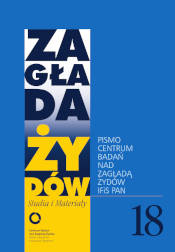 Zagłada Żydów.
Zagłada Żydów. 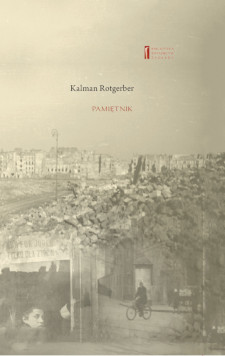 PAMIĘTNIK
PAMIĘTNIK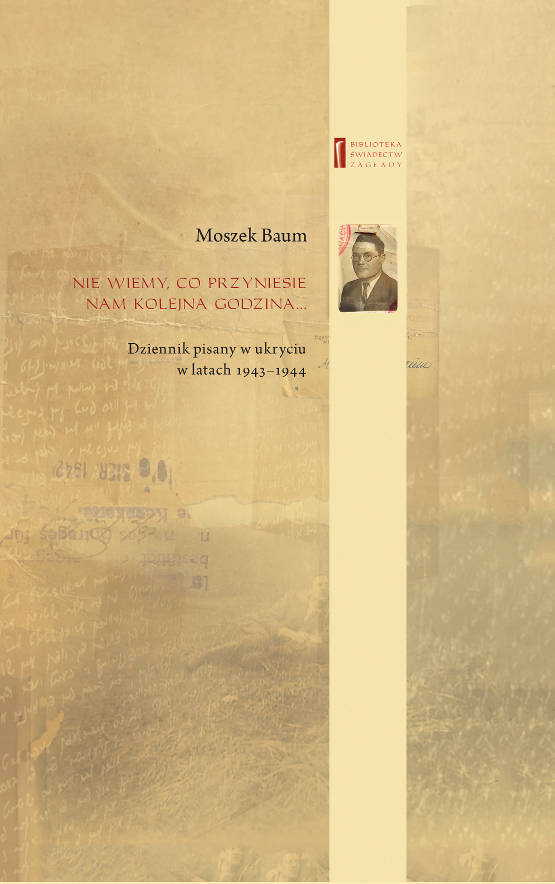 NIE WIEMY CO PRZYNIESIE NAM KOLEJNA GODZINA ...
NIE WIEMY CO PRZYNIESIE NAM KOLEJNA GODZINA ....jpg) Aryjskiego Żyda wspomnienia, łzy i myśli
Aryjskiego Żyda wspomnienia, łzy i myśli PISZĄCY TE SŁOWA JEST PRACOWNIKIEM
PISZĄCY TE SŁOWA JEST PRACOWNIKIEM.jpg) Zagłada Żydów.
Zagłada Żydów.  DALEJ JEST NOC. Losy Żydów w wybranych powiatach okupowanej Polski
DALEJ JEST NOC. Losy Żydów w wybranych powiatach okupowanej Polski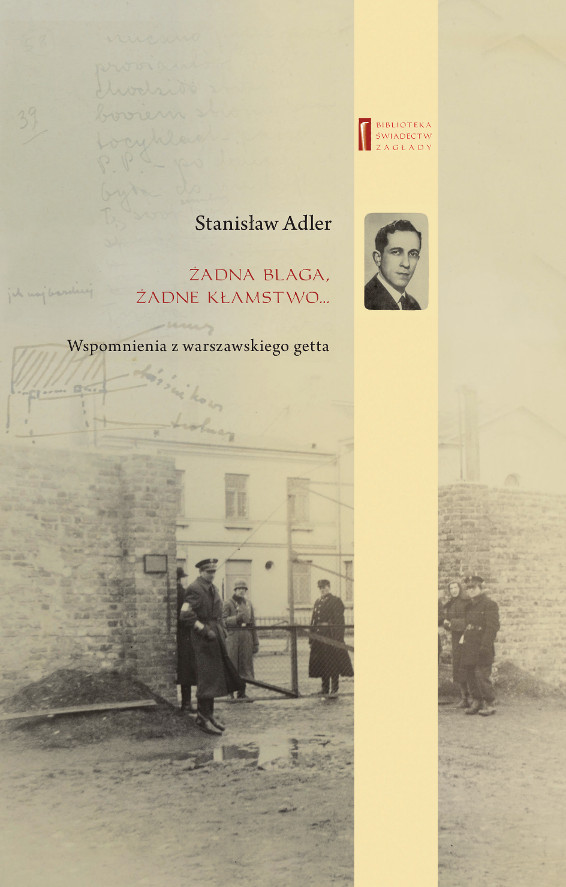 ŻADNA BLAGA, ŻADNE KŁAMSTWO ...
ŻADNA BLAGA, ŻADNE KŁAMSTWO ... 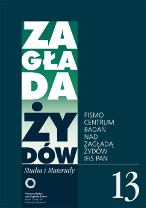 Zagłada Żydów.
Zagłada Żydów. TYLEŚMY JUŻ PRZESZLI ...
TYLEŚMY JUŻ PRZESZLI ... 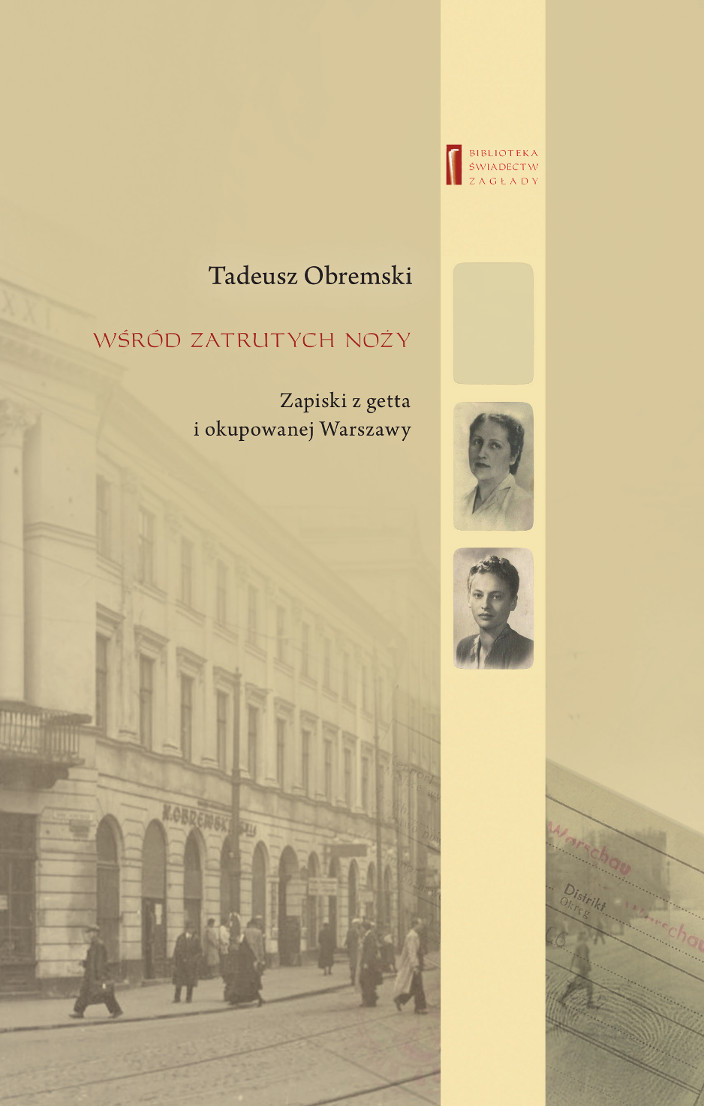 WŚRÓD ZATRUTYCH NOŻY ...
WŚRÓD ZATRUTYCH NOŻY ...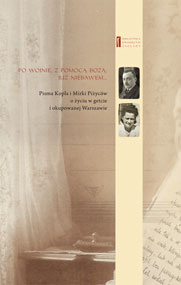 PO WOJNIE, Z POMOCĄ BOŻĄ, JUŻ NIEBAWEM ...
PO WOJNIE, Z POMOCĄ BOŻĄ, JUŻ NIEBAWEM ...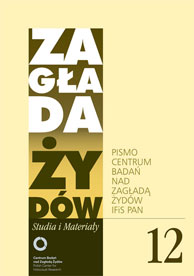 Zagłada Żydów.
Zagłada Żydów..jpg) SNY CHOCIAŻ MAMY WSPANIAŁE ...
SNY CHOCIAŻ MAMY WSPANIAŁE ...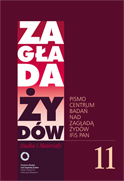 Zagłada Żydów.
Zagłada Żydów.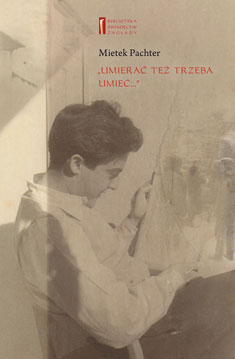 Mietek Pachter
Mietek Pachter Zagłada Żydów.
Zagłada Żydów.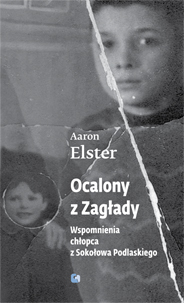 OCALONY Z ZAGŁADY
OCALONY Z ZAGŁADY ZAGŁADA ŻYDÓW. STUDIA I MATERIAŁY
ZAGŁADA ŻYDÓW. STUDIA I MATERIAŁY ... TĘSKNOTA NACHODZI NAS JAK CIĘŻKA CHOROBA ...
... TĘSKNOTA NACHODZI NAS JAK CIĘŻKA CHOROBA ...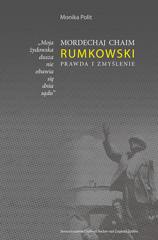 Monika Polit
Monika Polit.jpg) Dariusz Libionka i Laurence Weinbaum
Dariusz Libionka i Laurence Weinbaum.jpg) Zagłada Żydów.
Zagłada Żydów..jpg) Jan Grabowski
Jan Grabowski.jpg) Stanisław Gombiński (Jan Mawult)
Stanisław Gombiński (Jan Mawult).jpg) Żydów łamiących prawo należy karać śmiercią!
Żydów łamiących prawo należy karać śmiercią!.jpg) W Imię Boże!
W Imię Boże!.jpg) Żydzi w powstańczej Warszawie
Żydzi w powstańczej Warszawie Reportaże z warszawskiego getta
Reportaże z warszawskiego getta Notatnik
Notatnik.jpg) Holocaust
Holocaust .jpg) Źródła do badań nad zagładą Żydów na okupowanych ziemiach polskich
Źródła do badań nad zagładą Żydów na okupowanych ziemiach polskich.jpg) Utajone miasto.
Utajone miasto.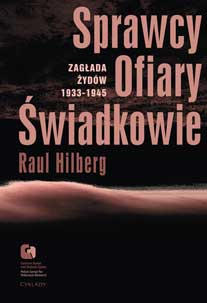 Sprawcy, Ofiary, Świadkowie.
Sprawcy, Ofiary, Świadkowie..jpg) 'Ja tego Żyda znam!'
'Ja tego Żyda znam!' 'Szanowny panie Gistapo!'
'Szanowny panie Gistapo!' Zagłada Żydów.
Zagłada Żydów.  PAMIĘTNIK
PAMIĘTNIK NIE WIEMY CO PRZYNIESIE NAM KOLEJNA GODZINA ...
NIE WIEMY CO PRZYNIESIE NAM KOLEJNA GODZINA ....jpg) Aryjskiego Żyda wspomnienia, łzy i myśli
Aryjskiego Żyda wspomnienia, łzy i myśli PISZĄCY TE SŁOWA JEST PRACOWNIKIEM
PISZĄCY TE SŁOWA JEST PRACOWNIKIEM.jpg) Zagłada Żydów.
Zagłada Żydów.  DALEJ JEST NOC. Losy Żydów w wybranych powiatach okupowanej Polski
DALEJ JEST NOC. Losy Żydów w wybranych powiatach okupowanej Polski ŻADNA BLAGA, ŻADNE KŁAMSTWO ...
ŻADNA BLAGA, ŻADNE KŁAMSTWO ...  Zagłada Żydów.
Zagłada Żydów. TYLEŚMY JUŻ PRZESZLI ...
TYLEŚMY JUŻ PRZESZLI ...  WŚRÓD ZATRUTYCH NOŻY ...
WŚRÓD ZATRUTYCH NOŻY ... PO WOJNIE, Z POMOCĄ BOŻĄ, JUŻ NIEBAWEM ...
PO WOJNIE, Z POMOCĄ BOŻĄ, JUŻ NIEBAWEM ... Zagłada Żydów.
Zagłada Żydów..jpg) SNY CHOCIAŻ MAMY WSPANIAŁE ...
SNY CHOCIAŻ MAMY WSPANIAŁE ... Zagłada Żydów.
Zagłada Żydów. Mietek Pachter
Mietek Pachter Zagłada Żydów.
Zagłada Żydów. OCALONY Z ZAGŁADY
OCALONY Z ZAGŁADY ZAGŁADA ŻYDÓW. STUDIA I MATERIAŁY
ZAGŁADA ŻYDÓW. STUDIA I MATERIAŁY ... TĘSKNOTA NACHODZI NAS JAK CIĘŻKA CHOROBA ...
... TĘSKNOTA NACHODZI NAS JAK CIĘŻKA CHOROBA ... Monika Polit
Monika Polit.jpg) Dariusz Libionka i Laurence Weinbaum
Dariusz Libionka i Laurence Weinbaum.jpg) Zagłada Żydów.
Zagłada Żydów..jpg) Jan Grabowski
Jan Grabowski.jpg) Stanisław Gombiński (Jan Mawult)
Stanisław Gombiński (Jan Mawult).jpg) Żydów łamiących prawo należy karać śmiercią!
Żydów łamiących prawo należy karać śmiercią!.jpg) W Imię Boże!
W Imię Boże!.jpg) Żydzi w powstańczej Warszawie
Żydzi w powstańczej Warszawie Reportaże z warszawskiego getta
Reportaże z warszawskiego getta Notatnik
Notatnik.jpg) Holocaust
Holocaust .jpg) Źródła do badań nad zagładą Żydów na okupowanych ziemiach polskich
Źródła do badań nad zagładą Żydów na okupowanych ziemiach polskich.jpg) Utajone miasto.
Utajone miasto. Sprawcy, Ofiary, Świadkowie.
Sprawcy, Ofiary, Świadkowie..jpg) 'Ja tego Żyda znam!'
'Ja tego Żyda znam!' 'Szanowny panie Gistapo!'
'Szanowny panie Gistapo!'![]() University of Ottawa
University of Ottawa


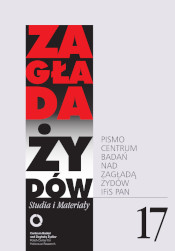

.jpg)
.jpg)


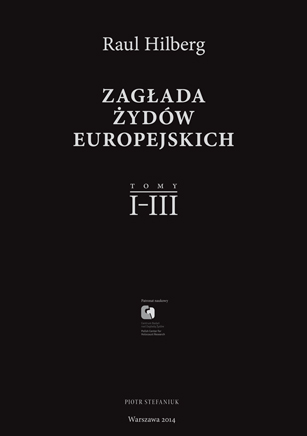
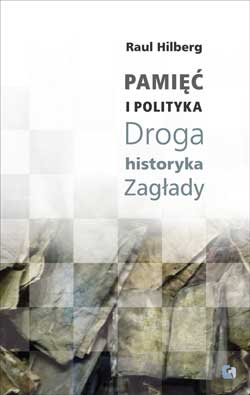
.jpg)
.jpg)
.jpg)
.jpg)
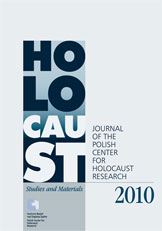

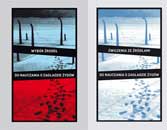
.jpg)
.jpg)
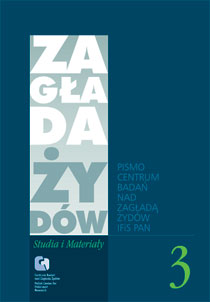
.jpg)
